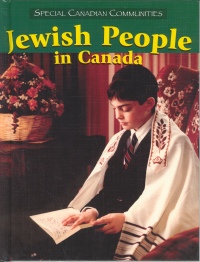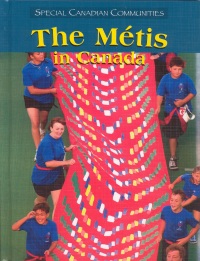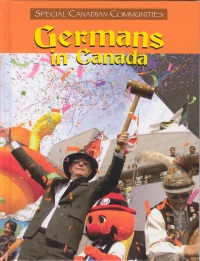| ________________
CM . . .
. Volume XII Number 7 . . . .November 25, 2005
A nonfiction book is judged on the basis of its accuracy and its ability to convey the information it contains. On both counts, the “Special Canadian Communities” series comes up short. After reading through these books several times, more and more inconsistencies appear to make the reader wonder if the series was pushed to publication too quickly without consideration to the fine points that make a book useful and effective. Consider the title Jewish People in Canada. Jewish people are commonly known as Jews. Hutterite people are commonly known as Hutterites, but the title of the book on their community is not “Hutterite People in Canada.” Would a book on Christians be called “Christian People in Canada”? Consider this excerpt from Jewish People in Canada:
For the information of the author and editors, Judaism is about 3500 years old (give or take a few centuries) and was the first monotheistic religion. Abraham was the first to worship one deity. He lived in Ur, a city in Babylonia, and wandered over the land that became Israel, but it was a far different Israel than children know about today. Abraham’s son, Isaac, was supposedly tested through the sacrifice of his son Jacob to prove his obedience to God. It was Jacob who later fathered the sons who became the leaders of the twelve tribes of Israel, the Jews. Let’s not forget that Jesus Christ, who lived 2000 years ago, was Jewish. His followers created the Christian church, long after he was dead. That historical information was gleaned from a simple Google search (Judaism origins). Young children who would be reading this book would take the information contained in it as gospel (pardon the pun) because teachers would have purchased the book assuming that the basic facts are correct. It is disturbing to think that the author and editors are putting this book out for public consumption. There are many more unclear statements in the same paragraph. On the first page, it states: “The first Jewish settlers came from western Europe.” Where? France? Holland? In the second paragraph, the reader is then informed that:
This information is imprecise. The first wave of Jewish immigration did come for the reasons stated (a general policy of anti-Semitism, or religious persecution). The second and much smaller group arrived on our shores because of the genocide carried out by the Nazis and collaborators in World War II. It’s not wrong to give young children facts. It informs them and makes them want to learn more. The book offers a map on page 5 which is of no use to a student researcher. The title of the map is “Eastern Europe.” The countries listed include those Eastern European nations from which Jews emigrated, but it also includes China, Mongolia and Iran and others. Their inclusion would be acceptable if the map or its caption offered some information, but it does not. It appears to be a climactic map, with the names of the countries printed in an eye-squinting font. The caption indicated the borders, which are already obvious by looking at the map. A “Think About It” box at the bottom of the page asks the reader to identify rivers, cities and landmarks—but none are shown. What is the point? On page 10, the author states: “Yiddish is a language spoken by about four million Jews across the world.” In reality, Yiddish is a language spoken by relatively few, and it is in sharp decline because of the numbers of people killed in World War II, because of assimilation and because modern Hebrew was declared the language of the new state of Israel in 1948. There are many more unclear and puzzling statements in this book. It appears to be an eclectic combination of information. The lamp used to celebrate Hanukkah is not identified (it’s called a hanukiah, or a Hanukka menorah) and it has a total of nine candles, while the text leads the reader to think that there are eight. A children’s book should include the name of the object, and if discussed, a picture or drawing would be in order. The two individuals named for their cultural contributions are Mordecai Richler and Izzy Asper—which seem out of place, since the other books do not name individuals. These choices also seem unusual and without consideration to the total history of the community. Websites are offered for further research, except that one of the addresses would exhaust any adult typing it in. “Hear the shofar being played in Jerusalem at: www.ujafedny.org/site/R?I=8UbiPEs3vmnLD9vZkw9xAw” Whew! Unfortunately, more can be said about this book. The most that should be said is that it should not be placed in any collection. Facts in The Métis in Canada were checked and appear to be generally correct. Yet this book, too, suffers from a muddled vision. The figure of Bonhomme, the snowman mascot of the Carnaval de Quebec, is shown on page 4. What is his relationship to the Métis? The symbol found on the Métis flag is also depicted but not explained anywhere in the book. On page 5, a climactic map of Western Europe includes Poland and Slovakia. Who immigrated to Canada from these countries that have a relationship to the Métis? And what is the purpose of the long-winded explanation of borders found in the caption? Instructions on how to weave a sash are found on page 21, but the best picture of the sash is on page 12. Given the target audience, a diagram would be expected if it is hoped that children will attempt and successfully accomplish this craft. Facts for Germans in Canada were also checked as much as possible and appear to be generally correct, although no mention is made of the spotlight that was put on the German-Canadian community in World War I, a situation which caused the name of Berlin, ON, to be changed to Kitchener (page 6). Since it’s mentioned, it should be explained. Other weaknesses jump out, such as the title “Learning German Language.” A more standard expression in English would be “Learning German” or “Speaking the German Language.” This reviewer was unable to check for the accuracy of Hutterites in Canada with members of the Hutterite community. The book offers the same format as the other three books, including a map on page 5 entitled “Czech Republic” that provides no explanation other than borders and directions. All the books reviewed above contain a table of contents, two-page chapters, many pictures, a recipe, instructions to make a craft, a question and answer page, a glossary and an index. On balance, these books are untrustworthy and weakly written. There are other series that would provide young children with reliable information, presented at their level. Not recommended. Harriet Zaidman is a teacher-librarian in Winnipeg, MB.
To comment
on this title or this review, send mail to cm@umanitoba.ca.
Copyright © the Manitoba Library Association. Reproduction for personal
use is permitted only if this copyright notice is maintained. Any
other reproduction is prohibited without permission.
NEXT REVIEW |
TABLE OF CONTENTS FOR THIS ISSUE
- November 25, 2005.
AUTHORS |
TITLES |
MEDIA REVIEWS |
PROFILES |
BACK ISSUES |
SEARCH |
CMARCHIVE |
HOME |



